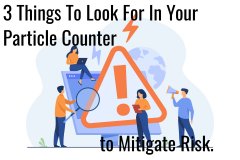Your particle counter is a foundational part of your cleanroom contamination control strategy, as it stands between you and contamination notification. But your particle counter has a wide array of electronics that should be monitored to ensure the reported data is accurate. There are a few things you can look for in your particle counter to ensure your data is accurate and reliable.
What Does Your Particle Counter’s Laser Do?
Your particle counter’s laser (the laser diode) is the light source in light scattering particle counters. The laser lases through the sample area and scatters when the beam hits a particle. The photodetector is able to recognize how much of the light was displaced. This allows the particle counter to quantify the number and size of particles!
This process is known as light scattering, and it’s commonly used in modern airborne particle counters. It is currently considered the best method for airborne particle counting.
Think about it like placing a bowling ball into a 5-gallon bucket of water. If the bucket were half full, the water level would rise when the bowling ball was added. The amount of water wouldn’t change, but it would be displaced in a way that you’d be able to figure out the volume of the bowling ball.
1. Laser Monitoring
What happens if your laser degrades or stops functioning correctly? Your readings would be way off or not existent. In a worst-case scenario, your laser would start to malfunction, and you wouldn’t know it. So you would be getting incorrect readings for an indeterminate amount of time and not know it.
Thus, when choosing your particle counter, make sure to pay attention to the self-diagnostics. So the particle counter will tell you when something is wrong. And you don’t have to find out during the annual service.
2. Internal Contamination Monitoring ( Photoamplifier monitoring)
The photo amplifier monitoring allows for notification if your sensor becomes contaminated with cleaning solution, dust or various other contaminants. Contamination of the sensor can lead to failed calibration and missed particles. Photoamplifier monitoring should be on the top of your list of what to look for in your particle counter.
The Photoamplifier monitoring on the ApexZ is so sensitive it can determine when cleaning solution overspray enters the sensor housing and when the overspray clears the sensor to allow you to continue to sample again with confidence.
3. Flow Rate Monitoring.
How is your particle counter measuring flow rate? Monitoring your flow rate ensures that you’re sampling the correct volume of air. Depending on your standard operating procedures, a specific volume of air needs to be sampled. Having a particle counter that monitors its flow rate ensures you constantly measure sample volume correctly!
What Sets A Particle Counter Apart?
We know you have hundreds of choices regarding which particle counter you choose, so what sets a particle counter apart from the rest? Well, it’s the details. It comes down to all the little things that go into building a particle counter. The little things have a big impact, and we know that.
Outside of the self-diagnostics, make sure to pay attention to your ideal particle counter’s sample flow rate, zero count, sensitivity, counting efficiency, channels, size range, and the ability to hold calibration. You should also note the service options, warranties, and follow-up of the company you decide to buy from.
A particle counter is not a trivial investment in your business and cleanroom. It is what stands between you and contamination and yield loss. So remember, it’s the little things that count.
If you want to make sure you’re getting the best particle counter for your situation, let us help match you with one.
(P.S. Are you looking to keep up with the industry? Or learn how to get the most out of your equipment? Check out our new Knowledge Center – where you can make a free account and gain access to hundreds of tech papers, articles, and videos that break down complex topics into digestible information. So you can always feel like the smartest person in the room!)


